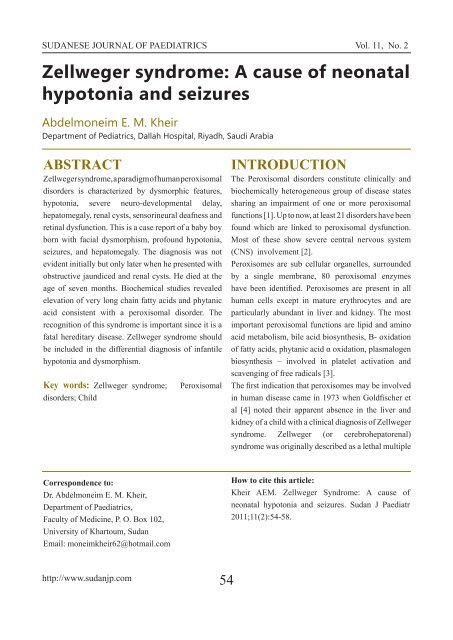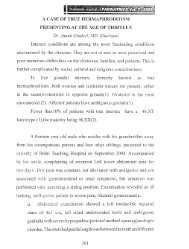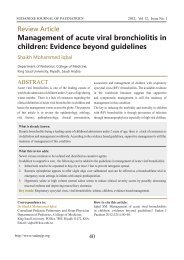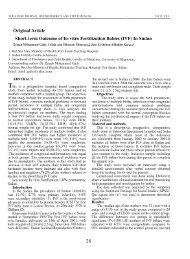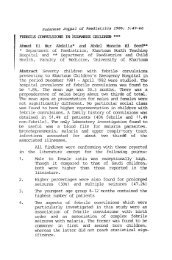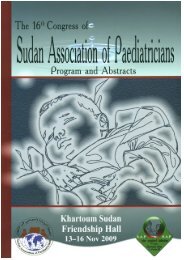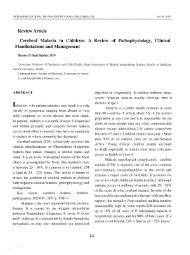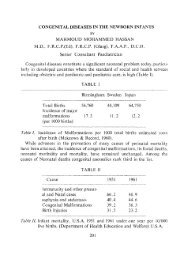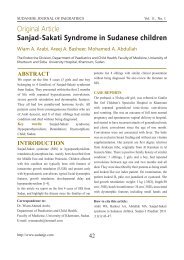Zellweger syndrome: A cause of neonatal hypotonia ... - Sudanjp.org
Zellweger syndrome: A cause of neonatal hypotonia ... - Sudanjp.org
Zellweger syndrome: A cause of neonatal hypotonia ... - Sudanjp.org
You also want an ePaper? Increase the reach of your titles
YUMPU automatically turns print PDFs into web optimized ePapers that Google loves.
SUDANESE JOURNAL OF PAEDIATRICS Vol. 11, No. 2<strong>Zellweger</strong> <strong>syndrome</strong>: A <strong>cause</strong> <strong>of</strong> <strong>neonatal</strong><strong>hypotonia</strong> and seizuresAbdelmoneim E. M. KheirDepartment <strong>of</strong> Pediatrics, Dallah Hospital, Riyadh, Saudi ArabiaABSTRACT<strong>Zellweger</strong> <strong>syndrome</strong>, a paradigm <strong>of</strong> human peroxisomaldisorders is characterized by dysmorphic features,<strong>hypotonia</strong>, severe neuro-developmental delay,hepatomegaly, renal cysts, sensorineural deafness andretinal dysfunction. This is a case report <strong>of</strong> a baby boyborn with facial dysmorphism, pr<strong>of</strong>ound <strong>hypotonia</strong>,seizures, and hepatomegaly. The diagnosis was notevident initially but only later when he presented withobstructive jaundiced and renal cysts. He died at theage <strong>of</strong> seven months. Biochemical studies revealedelevation <strong>of</strong> very long chain fatty acids and phytanicacid consistent with a peroxisomal disorder. Therecognition <strong>of</strong> this <strong>syndrome</strong> is important since it is afatal hereditary disease. <strong>Zellweger</strong> <strong>syndrome</strong> shouldbe included in the differential diagnosis <strong>of</strong> infantile<strong>hypotonia</strong> and dysmorphism.Key words: <strong>Zellweger</strong> <strong>syndrome</strong>;disorders; ChildPeroxisomalINTRODUCTIONThe Peroxisomal disorders constitute clinically andbiochemically heterogeneous group <strong>of</strong> disease statessharing an impairment <strong>of</strong> one or more peroxisomalfunctions [1]. Up to now, at least 21 disorders have beenfound which are linked to peroxisomal dysfunction.Most <strong>of</strong> these show severe central nervous system(CNS) involvement [2].Peroxisomes are sub cellular <strong>org</strong>anelles, surroundedby a single membrane, 80 peroxisomal enzymeshave been identified. Peroxisomes are present in allhuman cells except in mature erythrocytes and areparticularly abundant in liver and kidney. The mostimportant peroxisomal functions are lipid and aminoacid metabolism, bile acid biosynthesis, B- oxidation<strong>of</strong> fatty acids, phytanic acid α oxidation, plasmalogenbiosynthesis – involved in platelet activation andscavenging <strong>of</strong> free radicals [3].The first indication that peroxisomes may be involvedin human disease came in 1973 when Goldfischer etal [4] noted their apparent absence in the liver andkidney <strong>of</strong> a child with a clinical diagnosis <strong>of</strong> <strong>Zellweger</strong><strong>syndrome</strong>. <strong>Zellweger</strong> (or cerebrohepatorenal)<strong>syndrome</strong> was originally described as a lethal multipleCorrespondence to:Dr. Abdelmoneim E. M. Kheir,Department <strong>of</strong> Paediatrics,Faculty <strong>of</strong> Medicine, P. O. Box 102,University <strong>of</strong> Khartoum, SudanEmail: moneimkheir62@hotmail.comHow to cite this article:Kheir AEM. <strong>Zellweger</strong> Syndrome: A <strong>cause</strong> <strong>of</strong><strong>neonatal</strong> <strong>hypotonia</strong> and seizures. Sudan J Paediatr2011;11(2):54-58.http://www.sudanjp.com54
SUDANESE JOURNAL OF PAEDIATRICS Vol. 11, No. 2malformation <strong>syndrome</strong> <strong>of</strong> infancy [5].The crani<strong>of</strong>acial features <strong>of</strong> <strong>Zellweger</strong> <strong>syndrome</strong>are striking. These are characterized by paucity <strong>of</strong>facial movement with a large anterior fontanelle,prominent forehead, hypoplastic supraorbital ridgesand broad nasal root [6]. Other features includesevere neurological dysfunction, developmentaldelay with <strong>hypotonia</strong>, sensorineural hearing loss andocular abnormalities namely cataract, and optic nervehyoplasia. Hepatomegaly is seen in 80% <strong>of</strong> cases<strong>of</strong> <strong>Zellweger</strong> <strong>syndrome</strong> with raised levels <strong>of</strong> liverenzymes and bilirubin; renal cortical cysts are seen in70% <strong>of</strong> cases [7].The pattern <strong>of</strong> inheritance is autosomal recessive,and in three <strong>Zellweger</strong> patients mutations have beenshown to exist in two peroxisomal integral membraneproteins [8].The main stay <strong>of</strong> biochemical diagnosis <strong>of</strong> <strong>Zellweger</strong><strong>syndrome</strong> is the measurement <strong>of</strong> very long chainfatty acids (VLCFA) which have a chain length<strong>of</strong> 22 carbon atoms or greater [9]. Other clinicallyuseful assays exist for phytanic acid and pipecolicacid. Histological diagnosis is also possible throughliver biopsy by using the diaminobenzidine stainingprocedure to study the abundance, size and structure<strong>of</strong> liver peroxisomes [10].Prenatal diagnosis is also possible by direct analysis<strong>of</strong> levels <strong>of</strong> VLCFA and bile acid intermediates in theamniotic fluid. Another approach is the cytochemicalstaining <strong>of</strong> peroxisomes in chorionic villous sample.Detailed DNA studies, including immun<strong>of</strong>luorescenceand complementation assays, are now available forconfirmation and characterization <strong>of</strong> the pathologicalmutation [11-13]. Recent studies in the MiddleEast gave insight to the molecular phenotype <strong>of</strong>peroxisomal disorders in the Arab population [11-13].Unfortunately there is no effective treatment for<strong>Zellweger</strong> <strong>syndrome</strong> and patients usually die in thefirst year <strong>of</strong> life [14].CASE REPORTA male baby (Saudi) was delivered by emergencycaesarian section at term due to fetal distress andbreech presentation. His Apgar scores were 1in the 1st minute and 6 in the 5th minute. Hisanthropometric measurements were as follows:birth weight 2.47 kg; head circumference 33cm;and length 47cm.The baby needed active resuscitation at birthand was admitted to the <strong>neonatal</strong> intensivecare unit. Further clinical examination revealeddysmorphic features and <strong>hypotonia</strong> with a wideanterior fontanelle, long philtrum, high archedpalate and a broad nasal bridge.This was the first baby for a young couplewho are first degree relatives. There was noantenatal care. The initial arterial blood gasesshowed severe metabolic acidosis. Subsequentlyhe developed convulsions and was started onintravenous phenobarbitone. Blood sugar andbiochemistry were normal. Brain ultrasound wasnormal. All cultures were negative and weaned<strong>of</strong>f O2. The baby remained hypotonic with nosuck reflex and was commenced on nasogastricfeeding.The following investigations were also done andwere normal: complete blood count (CBC), ureaand electrolytes (U/E), calcium, magnesium,total serum bilirubin (TSB), creatine kinase,lactate and ammonia. TORCH screening wasalso negative and chromosomal analysis showednormal female karyotype. Investigations thatwere found to be abnormal include elevated liverenzymes (raised AST 304 IU/L, raised ALT 121IU/L). Echocardiography revealed a small atrialseptal defect (ASD II: secundum-type).The baby was discharged home on nasogastricfeeding, but was readmitted one week later withobstructive jaundice (TSB 125 mg/dl, direct 92.5mg/dl). Abdominal ultrasound showed multiple55http://www.sudanjp.com
SUDANESE JOURNAL OF PAEDIATRICS Vol. 11, No. 2renal cysts. HIDA scan and spinal X-ray werenormal.A clinical diagnosis <strong>of</strong> <strong>Zellweger</strong> <strong>syndrome</strong> wasmade and VLCFA were explored (Table 1). AnEEG was grossly abnormal and showed left focalepileptogenic activity consistent with partialseizures (Figure 1). MRI brain scan showeddelayed myelination <strong>of</strong> the white matter (Figure2) and no evidence <strong>of</strong> ischemic injury. DNAstudy and skin biopsy for peroxisomal function,immun<strong>of</strong>lorescence and complementationstudies were not done as the parents declinedfurther investigations. The baby had multipleadmissions with bronchopneumonia and wasO2 dependent at home. The baby later diedpeacefully at home at the age <strong>of</strong> 7 months.Table 1 Results <strong>of</strong> long chain fatty acid andphytanic acid*Fatty acid C22Fatty acid C24Fatty acid C26C24/C2227.1 μmol/L (21.1 – 102.8)53.9 μmol/L (22.2 – 86-5)↑9.6 μmol/L (0.05 – 1.9-7)ratio ↑ 1.99 (0.0 – 1.15)C /C ratio ↑0.354 (0.0 – 0.028)26 22Phytanic acid ↑ 39.89 μmol/L (0.0 – 10)Pristanate ↑ 11-15 μmol/L (0.0 – 1)* Reference values are in bracketsDISCUSSION<strong>Zellweger</strong>’s <strong>syndrome</strong> is a rare hereditarydisorder affecting infants and usually resultsin death. It was named after Hans <strong>Zellweger</strong>,a former pr<strong>of</strong>essor <strong>of</strong> paediatrics and geneticsat the University <strong>of</strong> lowa who researched thisdisorder. Patients with this <strong>syndrome</strong> usuallyhave typical facial dysmorphism which maybecome less characteristic if the patient survivesbeyond the first year <strong>of</strong> life. Zellwegr <strong>syndrome</strong>should be considered in any infant who presentswith <strong>hypotonia</strong> and facial dysmorphism [1-8]. In our case, the diagnosis was not evidentat birth despite the patient’s <strong>hypotonia</strong>, as thefacial dysmorphism was rather nonspecificand the diagnosis was only possible later onwhen he presented with prolonged conjugatedhyperbilirubinemia and routine abdominalultrasound showed renal cysts which are presentin 70% <strong>of</strong> cases <strong>of</strong> <strong>Zellweger</strong> <strong>syndrome</strong>.The diagnosis is usually confirmed by findingraised and phytanic acid, in addition tohistological detection by either liver biopsyor skin fibroblast culture, both were stronglyrefused by the parents <strong>of</strong> our case [1-4].Currently there is no cure for <strong>Zellweger</strong><strong>syndrome</strong> or a standard course <strong>of</strong> treatment.Infections should be guarded against toprevent complications such as pneumoniaand respiratory distress. Other <strong>cause</strong>s <strong>of</strong> deathinclude gastrointestinal bleeding and liverfailure. Treatment is mainly symptomatic andsupportive as patients do not survive beyond oneyear <strong>of</strong> age [14].In conclusion, <strong>Zellweger</strong> <strong>syndrome</strong> is one <strong>of</strong> manydysmorphic <strong>syndrome</strong>s subsequently shownto result from an inborn error <strong>of</strong> metabolism.Team work between the pediatrician, pediatricneurologist, clinical biochemist and geneticistis the key factor for further delineation; and therecognition <strong>of</strong> this <strong>syndrome</strong> is important since itis a fatal inherited disease. <strong>Zellweger</strong> <strong>syndrome</strong>should be included in the differential diagnosis<strong>of</strong> infantile <strong>hypotonia</strong> and dysmorphism.http://www.sudanjp.com56
SUDANESE JOURNAL OF PAEDIATRICS Vol. 11, No. 2Figure 1: An electroencephalogram was grosslyabnormal and showed left focal epileptogenic activity(arrows) consistent with partial seizures.Figure 2: Coronal cut <strong>of</strong> brain MRI showing delayedmyelination <strong>of</strong> the white matter.ACKNOWLEDGEMENTI would like to thank the family <strong>of</strong> the baby mentionedin this report for permitting the use <strong>of</strong> the casedetails. Thanks are also extended to the biochemistrydepartment at Dallah Hospital in Riyadh. I amindebted to Dr. Tarig Dirar, Research Assistant at theSudan Medical and Scientific Research Institute, forhis guidance and assistance during writing up <strong>of</strong> thiscase report.57http://www.sudanjp.com
SUDANESE JOURNAL OF PAEDIATRICS Vol. 11, No. 2REFERENCES1. Fournier B, Smeitink JAM, Dorland L, Berger R, Saudubray JM, Poll. Peroxisomal disorders : a review. J InheritedMetab Dis. 1994. 17: 470-386.2. Wander RJA, Heymans HAS, Schutgens RBH, Barth PG, Vander Bosch H, Tager JM. Peroxisomal disorders inneurology. J Neurol Sci. 1988. 88: 1-39.3. Vander Bosch H, Schutgens RBH, Wander RJA, TagerJG. Biochemistry <strong>of</strong> peroxisomes. Annu Rev Biochem. 1992.61: 157-197.4. Goldfischer S, Moore CL, Johnson AB, Spiro AJ, Valsamis MP, Wisniewski HK, et al. Peroxisomal and mitochondrialdefects in cerebrohepatorenal <strong>syndrome</strong>. Science. 1973;182:62-4.5. Bowen P, Lee CSN, <strong>Zellweger</strong> H, Lindenberg R. A familial <strong>syndrome</strong> <strong>of</strong> multiple congenital defects. Bull JohnsHopkins Hosp. 1964; 114: 402-14.6. Fitzpatrick DR , <strong>Zellweger</strong>’s <strong>syndrome</strong> and associated phenotype, J M genet 1996;33(10):863-868.7. Gilchrist KW, Gilbert EF, Shahidi NT, opitzJM. the evaluation <strong>of</strong> infants with <strong>Zellweger</strong>’s <strong>syndrome</strong>, Clin genet1975; 7:413-16.8. Gartner J, Moser H, Valle D. Mutations in the 70K Peroxisomal membrane protein gene in <strong>Zellweger</strong>’s <strong>syndrome</strong>,Nat Genet. 1992 ; (1) :16-23.9. Wanders RJA, Schrakamp G, van den Bosch H, Tager JM, Moser HW, Moser, AE, et al. Pre and postnatal diagnosis<strong>of</strong> <strong>Zellweger</strong>’s <strong>syndrome</strong>. J Inherit Metab Dis. 1986; 9 (2)317-320.10. Roels F, Espeel M, de Craemer D. Liver pathology and immunecytology in congenital peroxisomal diseases: areview. J Inherired Metab Dis. 1991; 14 :853-875.11. Shaheen R, Al-Dirbashi ZN, Al-Hassnan OY, Al-Owain M, Makhsheed N, Basheeri F, et al. Clinical, biochemicaland molecular characterization <strong>of</strong> peroxisomal diseases in Arabs. Clin Genet 2010;1-11.12. Al-Dirbashi OY, Shaheen R, Al-Sayed M, Al-Dosari M, Makhseed N, Abu Safieh L, et al. <strong>Zellweger</strong> <strong>syndrome</strong><strong>cause</strong>d by PEX13 deficiency: report <strong>of</strong> two novel mutations. Am J Med Genet A. 2009 ;149A(6):1219-23.13. Mohamed S, Elmeleagy E, Nasr A, Ebberink M, Wanders R, Waterham H. A Mutation in PEX19 Causes a Severe ClinicalPhenotype in a Patient With Peroxisomal Biogenesis Disorder. Am J Med Genet Part A 2010; 152A:2318–2321.14. Steinberg S, Dodt G, Raymond G, Braverman N, Moser A, Moser H. Peroxisomes biogenesis disorders. BiochimicaBiophysica. 2006; 1733-1763.http://www.sudanjp.com58


